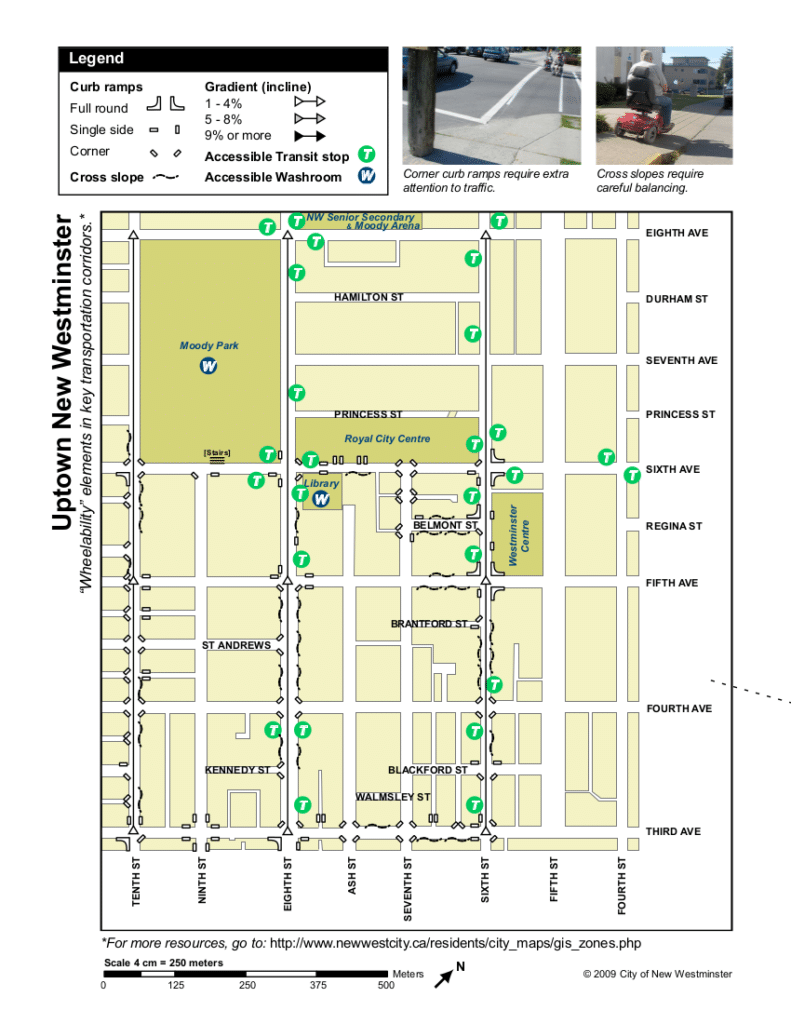New Westminster’s Seniors Advisory Committee, Seniors Planning & Action Network (SPAN), and Special Services and Access Committee all advise elected officials about decisions regarding community issues. Leading up to 2009, there had been multiple discussions with these bodies about issues facing the aging population in New Westminster, especially in the Uptown area where about a quarter of the population is comprised of seniors. Also, city staff noticed an increase in inquiries and complaints from older adults about barriers to active transportation. The City decided to identify and address issues impairing mobility among seniors, people who use mobility aids, and people with disabilities. This led to the development and successful implementation of the New Westminster Wheelability Assessment Project.
Partnerships and Stakeholders
- New Westminster
- Elected officials
- Development Services Department (Planning)
- Engineering Department
- Seniors Advisory Committee
- Access Ability Advisory Committee
- Seniors Planning & Action Network (SPAN)
- Community residents with mobility concerns
- Fraser Health Authority
Summary of the Process
With assistance from SPAN, the City successfully applied and received funding from the Built Environment and Active Transportation (BEAT) and Community Grant Planning Program offered by the Union of BC Municipalities (UBCM). The $25,000 grant covered expenses for the Wheelability Assessment Project.The goal was to improve transportation conditions for those who utilize a scooter, wheelchair, walker or other mobility aid. Older adults and those with mobility limitations were targeted for this project.
First, city staff conducted research about wheelability audit tools, created a wheelability audit, and piloted a pre-assessment of the built environment. This objective assessment included measuring the gradient of route segments, identifying locations of curb cuts and permanent street furniture, and cataloguing pedestrian crossing times and many other built environment features.
Next, a two-day community assessment of the two core areas of New Westminster (Uptown and Downtown) was completed. This was one of the most valuable components of the project. Over 45 community members with mobility limitations, city councillors, and staff walked the two core areas of New Westminster. Community members voiced their concerns directly to city staff and elected officials. These concerns were categorized under five themes: design (e.g., sidewalk surface treatments), maintenance (e.g., cracking of sidewalks), guidelines (e.g., street crossing signal times), enforcement (e.g. business’ sidewalk signage) or other (e.g., impatient drivers).
Lastly, a Community Survey Profile was distributed to gather information about demographics, preferred travel routes, and built environment barriers. Responses were received from 121 people who use mobility aids.
The assessment and survey results led to the creation of two wheelability maps, one of Uptown and another of Downtown. These maps include the placement of accessible transit stops and washrooms, curb ramps, cross-slopes, and sidewalk gradients. Recommendations from this research were presented to City Council, which have ultimately informed policies, practices, and design decisions related to wheelability.
Check out this video:
Outcomes and Impact
- Establishment of a strong, meaningful relationship between community residents, city staff, and elected officials has allowed residents to comfortably voice their concerns, while elected officials are now more aware of the community’s needs.
- Information from the Wheelability Assessment has been incorporated into the City’s new Master Transportation Plan and Official Community Plan.
- Between 2010 and 2014, the City allocated $50,000 for accessibility upgrades. In addition, $75,000 was used in 2010, and $100,000 in 2011 for sidewalk upgrades and replacement, while $150,000 was set-aside for the future.
- The north sidewalk of Carnarvon Street and curb ramps at Carnarvon and Eighth Street (a high pedestrian area) have been replaced, and the aesthetic brick sidewalks were discontinued soon after.
- Queensborough, an area of New Westminster undergoing rapid growth, is being considered for the next Wheelability Assessment.
Keys to Success
- Elected officials, city staff, and community members collaborated to foster a positive, trusting relationship which allowed residents to freely express their concerns directly to decision makers. This awareness within the City led to immediate action to resolve the issues.
For more information, contact:
John Stark
Senior Social Planner
jstark@newwestcity.ca
604-515-3777





